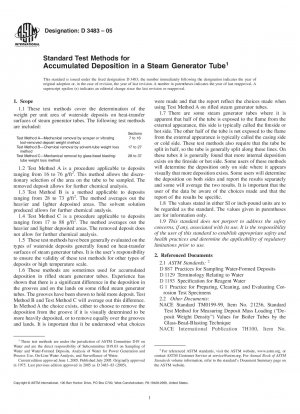ASTM D3483-05
Standard Test Methods for Accumulated Deposition in a Steam Generator Tube
- Standard No.
- ASTM D3483-05
- Release Date
- 2005
- Published By
- American Society for Testing and Materials (ASTM)
- Status
- Replace By
- ASTM D3483-05(2009)
- Latest
- ASTM D3483-14(2022)
- Scope
The weight per unit area measurement is an indication of the relative cleanliness or dirtiness of the boiler. It is used to determine the effectiveness of the boiler chemical treatment program and to determine the need for chemically cleaning the boiler systems. Allowing the internal deposition to accumulate unchecked will likely lead to boiler tube failures by mechanisms of under deposit corrosion and tube metal overheating.
1.1 These test methods cover the determination of the weight per unit area of waterside deposits on heat-transfer surfaces of steam generator tubes. The following test methods are included:
Sections Test Method A-Mechanical removal by scraper or vibrating tool-removed deposit weight method 7 to 16 Test Method B-Chemical removal by solvent-tube weight loss method 17 to 27 Test Method C-Mechanical removal by glass-bead blasting-tube weight loss method 28 to 37 1.2 Test Method A is a procedure applicable to deposits ranging from 16 to 76 g/ft2. This method allows the discretionary selection of the area on the tube to be sampled. The removed deposit allows for further chemical analysis.
1.3 Test Method B is a method applicable to deposits ranging from 28 to 73 g/ft2. The method averages out the heavier and lighter deposited areas. The solvent solution produced allows for further chemical analysis.
1.4 Test Method C is a procedure applicable to deposits ranging from 17 to 88 g/ft2. The method averages out the heavier and lighter deposited areas. The removed deposit does not allow for further chemical analysis.
1.5 These test methods have been generally evaluated on the types of waterside deposits generally found on heat-transfer surfaces of steam generator tubes. It is the users responsibility to ensure the validity of these test methods for other types of deposits or high temperature scale.
1.6 These methods are sometimes used for accumulated deposition in rifled steam generator tubes. Experience has shown that there is a significant difference in the deposition in the grooves and on the lands on some rifled steam generator tubes. The grooves have been shown to hold more deposit. Test Method B and Test Method C will average out this difference. In Method A the choice exists, either to choose to remove the deposition from the groove if it is visually determined to be more heavily deposited, or to remove equally over the grooves and lands. It is important that it be understood what choices were made and that the report reflect the choices made when using Test Method A on rifled steam generator tubes.
1.7 There are some steam generator tubes where it is apparent that half of the tube is exposed to the flame from the external appearance, this side is typically called the fireside or hot side. The other half of the tube is not exposed to the flame from the external appearance is typically called the casing side or cold side. These test methods also require that the tube be split in half, so the tube is generally split along these lines. On these tubes it is generally found that more internal deposition exists on the fireside or hot side. Some users of these methods will determine the deposition only on side where it appears visually that more deposition exists. Some users will determine the deposition on both sides and report the results separately and some will average the two results. It is important that the user of the data be aware of the choices made and that the report of the results be specific.
1.8 The values stated in either SI or inch-pound units are to be regarded as the standard. The values given in parentheses are for information only.
1.9 This standard does not purport to address the safety concerns, if any, associated with its use. It is the responsibility of t......
ASTM D3483-05 Referenced Document
- ASTM D1129 Standard Terminology Relating to Water
- ASTM D1193 Standard Specification for Reagent Water
- ASTM D887 Standard Practices for Sampling Water-Formed Deposits
- ASTM G1 Standard Practice for Preparing, Cleaning, and Evaluating Corrosion Test Specimens
ASTM D3483-05 history
- 2022 ASTM D3483-14(2022) Standard Test Methods for Accumulated Deposition in a Steam Generator Tube
- 2014 ASTM D3483-14 Standard Test Methods for Accumulated Deposition in a Steam Generator Tube
- 2005 ASTM D3483-05(2009) Standard Test Methods for Accumulated Deposition in a Steam Generator Tube
- 2005 ASTM D3483-05 Standard Test Methods for Accumulated Deposition in a Steam Generator Tube
- 1983 ASTM D3483-83(2005) Standard Test Methods for Accumulated Deposition in a Steam Generator Tube
- 1983 ASTM D3483-83(1999) Standard Test Methods for Accumulated Deposition in a Steam Generator Tube
